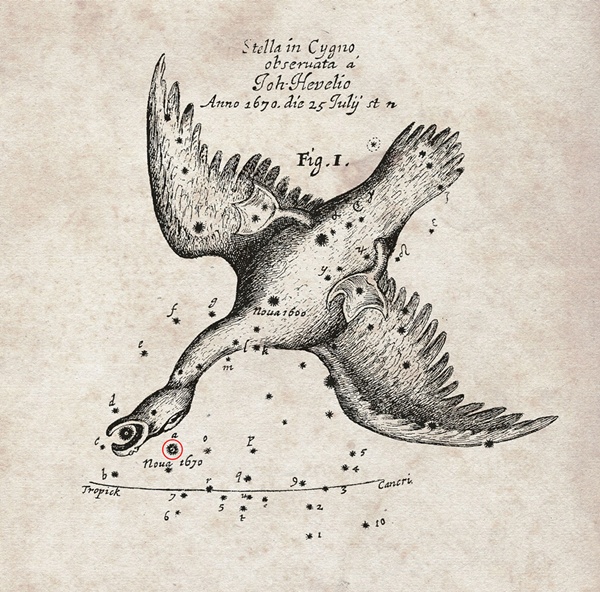Astronomers Explain the Enigmatic 17th Century Stellar Explosion
| Marco Foronda | | Mar 24, 2015 12:01 PM EDT |
(Photo : Royal Society) This chart of the position of a nova (marked in red) that appeared in the year 1670 was recorded by the famous astronomer Hevelius.
A mysterious explosion seen by astronomers in the 17th century wasn't a nova but a far more rare and violent type of stellar collision.
According to the European Southern Observatory (ESO), APEX and other telescopes observed the remnants of the 1670 stellar collision was seen easily with the naked eye during its first eruption/ But now, it had to be analyzed with powerful sub-millimeter telescopes to discover the true source of these unusual explosions.
Like Us on Facebook
Johannes Hevelius, who discovered seven still-recognized constellations and has been dubbed the father of lunar topography, was among the astronomers that documented the appearance of a new star in the skies in 1670. Originally described by Hevelius as nova sub capite Cygni (a new star below the head of the swan), it is now known as Nova Vulpeculae 1670.
"For many years this object was thought to be a nova, but the more it was studied the less it looked like an ordinary nova -- or indeed any other kind of exploding star," said study lead author Tomasz Kaminski, now with ESO, of Max Planck Institute for Radio Astronomy (MPIfR) at the time of discovery.
At first, Nova Vul 1670 was easily visible and its brightness varied over the following two years. Despite documentation, early astronomers did not have the equipment needed to unravel the mystery of the nova's performance.
Astronomers came to realize that most novae could be explained by the explosive behavior of close binary stars during the 1900s, but the model still didn't seem to apply to Nova Vul 1670, so it remained a mystery. It wasn't until the 1980s that astronomers first realized that Nova Vul 1670 did not disappear completely, but that a faint nebula remained around its location.
Kamiński and his colleagues investigated that area using the APEX telescope, the Submillimeter Array (SMA), and the Effelsberg radio telescope. They found a cool gas that had an unusual chemical composition surrounding the remnant. They were able to compile a detailed account of the region's makeup.
The new study was published in the journal Nature.
TagsAstronomers Explain the Enigmatic 17th Century Stellar Explosion, 17th Century Explosion, stellar collision, Nova Vul 1670, Supernova, Nova, space exploration
©2015 Chinatopix All rights reserved. Do not reproduce without permission
EDITOR'S PICKS
-

Did the Trump administration just announce plans for a trade war with ‘hostile’ China and Russia?
-

US Senate passes Taiwan travel bill slammed by China
-

As Yan Sihong’s family grieves, here are other Chinese students who went missing abroad. Some have never been found
-

Beijing blasts Western critics who ‘smear China’ with the term sharp power
-

China Envoy Seeks to Defuse Tensions With U.S. as a Trade War Brews
-

Singapore's Deputy PM Provides Bitcoin Vote of Confidence Amid China's Blanket Bans
-

China warns investors over risks in overseas virtual currency trading
-

Chinese government most trustworthy: survey
-

Kashima Antlers On Course For Back-To-Back Titles
MOST POPULAR
LATEST NEWS
Zhou Yongkang: China's Former Security Chief Sentenced to Life in Prison

China's former Chief of the Ministry of Public Security, Zhou Yongkang, has been given a life sentence after he was found guilty of abusing his office, bribery and deliberately ... Full Article
TRENDING STORY

China Pork Prices Expected to Stabilize As The Supplies Recover

Elephone P9000 Smartphone is now on Sale on Amazon India

There's a Big Chance Cliffhangers Won't Still Be Resolved When Grey's Anatomy Season 13 Returns

Supreme Court Ruled on Samsung vs Apple Dispute for Patent Infringement

Microsoft Surface Pro 5 Rumors and Release Date: What is the Latest?










